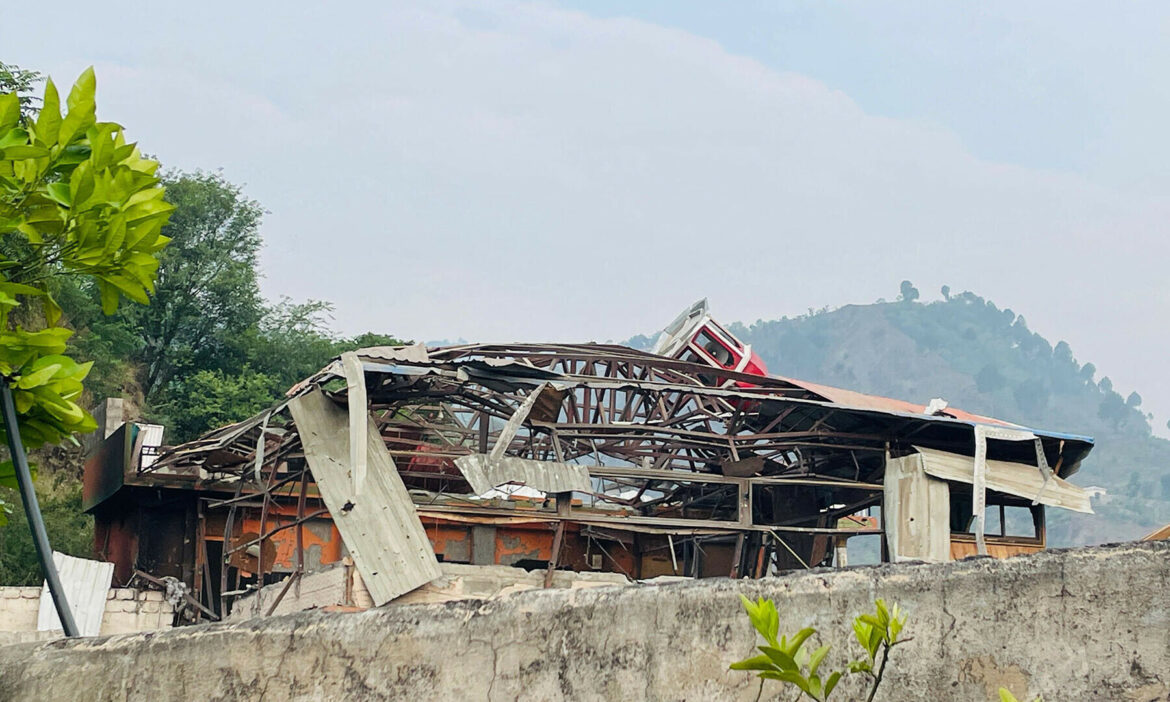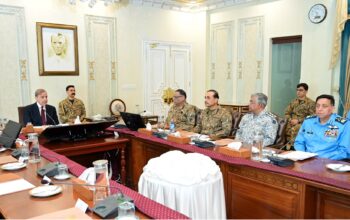By Staff Reporter
ISLAMABAD: Pakistan and India plunged into their most severe military confrontation in over five decades early Wednesday, as Pakistan claimed it shot down five Indian fighter jets in retaliation for India’s cross-border air strikes.
The dramatic escalation, which left at least 26 Pakistanis dead and 46 injured, has stoked fears of an uncontrolled spiral into a broader conflict between the two nuclear-armed rivals.
The clashes erupted around 1 a.m. local time when Indian forces launched “Operation Sindoor,” striking six sites across Pakistan that New Delhi claimed housed “terrorist infrastructure.”
Pakistan’s military swiftly countered, downing two Indian jets by 2:45 a.m. and three more in the hours that followed, according to officials in Islamabad. The Pakistani military reported 24 “impacts” across six locations, including the cities of Ahmedpur East, Muridke, and Sialkot, as well as Kotli, Bagh, and Muzaffarabad in Azad Kashmir.
In Ahmedpur East, a missile strike on a mosque killed five people, including a three-year-old girl. Similar attacks damaged houses of worship in Muzaffarabad, Kotli, and Muridke, where officials also cited economic losses and destruction in “potter’s quarters.”
Witnesses in Muzaffarabad, the capital of Azad Kashmir, reported multiple loud explosions followed by a power blackout across the city.
The hostilities follow weeks of mounting tension sparked by an attack in occupied Kashmir last month that killed 26 tourists. India alleged Pakistan’s involvement but offered no public evidence, prompting Islamabad to call for an independent investigation.
The two nations, which have fought three wars since their partition in 1947—primarily over Kashmir—had maintained a fragile ceasefire along the Line of Control (LoC) since 2021, though sporadic exchanges of fire had intensified in recent months.
India’s government defended its strikes as a targeted operation. “A little while ago, the Indian armed forces launched ‘OPERATION SINDOOR,’” it said in a statement. “Our actions have been focused, measured and non-escalatory in nature. No Pakistani military facilities have been targeted. India has demonstrated considerable restraint in selection of targets and method of execution.”
Pakistan, however, viewed the strikes as an act of aggression. Prime Minister Shehbaz Sharif denounced them as a “cowardly attack” and pledged a robust response. “The Pakistani nation and the Pakistani armed forces know how to deal with the enemy very well,” Sharif said. “The enemy will never be allowed to succeed in his nefarious objectives.”
Sharif convened an emergency meeting of the National Security Committee at 10 a.m. to finalize Pakistan’s next steps.
Islamabad has informed the UN Security Council (UNSC) about the “blatant aggression by India and the threat it posed to international peace and security”, Pakistan’s foreign ministry says in a statement.
“UNSC has been informed that Pakistan reserves the right to respond appropriately to this aggression at a time and place of its choosing, in accordance with its right to self-defence as enshrined in Article 51 of the United Nations Charter,” it added.
Pakistan’s military detailed a fierce counterattack. Defense Minister Khawaja Asif told Bloomberg TV that the downed Indian aircraft included “three Rafales, a Russian Su-30, and a MiG-29,” along with multiple drones.
Information Minister Attaullah Tarar elaborated, saying Pakistan had downed the jets “in Akhnoor, Ambala, Barnala and in Jammu,” while also neutralizing quadcopters and a large drone.
CNN reported that pictures taken of parts of an aircraft that crashed in occupied Kashmir “show the label of a French manufacturer, lending support to Pakistan’s claims that it had shot down three of India’s top-of-the-line Rafale fighter jets”.
“The label shows an aircraft part from French filtration company Le Bozec et Gautier. Le Bozec is a French-based subsidiary of Minnesota’s Donaldson Company”.
Lt. Gen. Ahmed Sharif Chaudhry, the military’s spokesperson, vowed a resolute response at a news conference. “This unprovoked, cowardly attack will be met with a befitting response,” he said. “We are giving it and will continue to give it. Let me say it unequivocally, Pakistan will respond to this [attack] at a time and place of its choice. This provocation will not go unanswered.”
Chaudhry, at his second media briefing, said the military had shot down five Indian fighter jets and a combat drone in what he described as a defensive response to the Indian attack.
Director General of Inter-Services Public Relations said India has violated Pakistan’s sovereignty and has targeted civilian infrastructure. “India cowardly attacked Pakistan and violated its sovereignty,” he said. “In response to the enemy’s aggression and in defense, the Pakistan Army has downed five jets and one combat drone of the enemy that attacked Pakistan.”
Chaudhry said the Indian attack targeted the Nauseri Dam structure of the Neelum-Jhelum Hydropower Project, which he termed “an unacceptable and a dangerous escalation.”
Military spokesman questioned India’s intentions, asking, “Is India trying to damage the water of Pakistan’s people? Does it know the consequences and meaning of this?”
He also invoked international norms, stating, “Do international norms and war laws allow you to target the water reservoirs, dams and hydropower structures?”
Gen Chaudhry highlighted the risk to civilian aviation during the attack, noting that there were 57 international flights operating in Pakistan’s airspace at the time.
“During this cowardly act, many national and international flights were in the air and thousands of lives were put in grave danger,” he said, adding that the consequences of any of those being hit “perhaps did not cross the minds of those who were undertaking this senseless aggression.”
Chaudhry detailed Pakistan’s response, explaining that the Indian jets were engaged and shot down after they had released their weapons. “The Pakistan Air Force brought these jets down when they attacked Pakistan, only after they released their weapons,” he said. “They were engaged and shot at once they took on unprovoked and uncalled-for aggression against the state, the territorial integrity and innocent people of Pakistan by firing at them.”
The downed aircraft included three Rafael jets, one MiG-29, and one SU plane, as well as an Heron combat drone. The jets were brought down in various locations: one each in General Area Bhatinda, Jammu, Akhnoor, and Srinagar, and two in Avantipur.
“It should also be noted that the Pakistan Armed Forces could have shot at even more than 10 of their aircraft but we exercised restraint.”
In addition to downing the aircraft, the Pakistani military destroyed several Indian checkposts and a brigade headquarters.
During the press conference, footage was shown of the destruction of checkposts identified as Chhatri, Jura, and Sarlia-1, as well as a unit battalion headquarters and a brigade headquarters from where, Gen Chaudhry said, India was violating the Line of Control (LoC) ceasefire.
He clarified that no airspace violations occurred during the engagement. “At no time, any of their aircraft were allowed to enter into Pakistan’s airspace and also at no time, none of Pakistan’s aircraft went into Indian airspace.”
Chaudhry emphasized Pakistan’s resolve to continue defending itself. “Pakistan is responding fully to this Indian aggression and will keep responding,” he said, vowing to respond at a time “of our own choice.” “India’s misconceptions would be corrected.” In a striking statement, he asserted, “We in the armed forces love and embrace martyrdom much and much more than we fear death.”
In response to the crisis, Pakistan declared an emergency in Punjab, its largest and most populous province. The provincial chief minister ordered schools closed, hospitals on high alert, and security forces mobilized.
A spokesperson for Pakistan International Airlines said flights in the air were diverted to Karachi, while those on the ground were grounded indefinitely.
Analysts described the strikes as the most significant military action in the region since the 1971 war. “This is not just limited to Kashmir,” said Sushant Singh, a lecturer at Yale University. “This is mainland Pakistan. This is Pakistani heartland.” Singh warned that Pakistan’s retaliation could dictate the conflict’s trajectory. “If they hit inside Indian Punjab or Rajasthan,” he said, referring to states bordering Pakistan, “we are looking at a different scale.”
Michael Kugelman, a South Asia expert in Washington, underscored the stakes. “Any military confrontation is dangerous, no matter how limited,” he said. “Neither country has any interest in a hot war … but one shouldn’t be complacent about the risks of miscalculations.”
The international community moved quickly to contain the crisis. U.S. President Donald Trump, speaking at the White House, expressed alarm. “It’s a shame, we just heard about it,” he said. “I guess people knew something was going to happen based on the past. They’ve been fighting for many, many decades and centuries, actually, if you really think about it. I just hope it ends very quickly.”
Secretary of State Marco Rubio engaged Indian officials, urging de-escalation, while a State Department statement warned, “The world cannot afford a military confrontation between India and Pakistan.”
United Nations Secretary General António Guterres was “very concerned,” a spokesperson said, calling for both sides to exercise restraint. The UN’s plea echoed a global chorus of anxiety over the potential for a nuclear exchange.
Copyright © 2021 Independent Pakistan | All rights reserved




